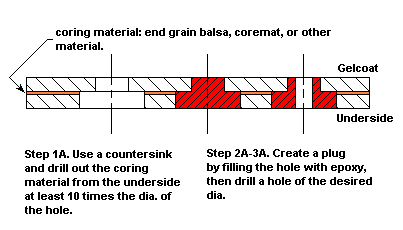Ben:
The fungus that rots wood requires four “ingredients:” oxygen, moisture, heat and food (wood). Take away anyone of those ingredients and the rot can not spread. The fungus spores are still there but they can not spread. Information about wood rotting fungus may be found at Site | Ohioline .
Now that we have the academics out of the way. let’s discuss Elizabeth’s little problem. When we rebuilt one of our boats, we discovered a small section of rot in a plywood partial bulkhead. I drilled small holes into the edge of the plywood, mounted syringes in the holes then fill the syringes with Clear Penetrating Epoxy System (CPES). The cure time for this epoxy is 1 to 3 days and it has the viscosity of water. The epoxy penetrates through the wood and “petrifies” it. The resultant structure is as sound as the surrounding wood.
http://www.rotdoc.com/index.html
If I were doing the job, I would dry the coring per Bob and Lois earlier post. Once the wood was dry, I would setup tubes in the 1/4" drill holes, i.e. stand pipes. If possible, I would use 12" long tubes. When filled with liquid, the hydrostatic pressure will be about 0.4 psi for a 12" vertical tube. After inserting the tubes in the holes, fill the tubes with CPES and keep filling the tubes as the CPES penetrates the rotted wood. The CPES will also penetrate into the coring not affected by the fungus but it will not penetrate as fast as in the rotted coring. You want the CPES to penetrate the unaffected wood to ensure the CPES encapsulates any spores that may have traveled into the unaffected coring. Once, the CPES has cured, I would route out the coring around the hole and fill the space with filled epoxy. The stand pipes can be cut off, drilled out and the hole repaired with filled epoxy. The key to the success of the repair is to ensure the coring is dry. Another approach to drying the coring is to fill the stand pipes with acetone (requires metal stand pipes). The acetone will “carry” the water out of the wood but it will be necessary to let most of the acetone evaporate from the coring before applying CPES. A couple of heat lamps can be used to drive the acetone from the coring. Warning, acetone is highly flammable, hence no sparks or open flames. Make sure the cabin is well ventilated to prevent acetone vapors from concentrating in the cabin. You do not need to be the first astronaut sailor.
I looked at the photos on your blog and do not believe the small area of rot around the vent holes will affect the structural integrity of the cabin top. BCC’s are “built stout strong.” These holes are relatively small compared to the holes cut into the cabin top for the skylight hatch and companionway.
The bulwark area shown in the photo on your blog can be remedied by cutting out the area and bonding a dutchman into the hole.
I like dutchman patches that have tapered edges. i.e. a mini-scarf joint around the dutchman. A stepped scarf will work just as well and is easier to make. I would use epoxy filled with micro-fibers to bond the dutchman into the bulkhead.
The small amount of rot you have found is insignificant compared to the rot we found in African Moon’s aft cabin and engine well. I could stick my finger through some of the rotted areas. Repair was not an option. We ripped out the engine well, after cabin, cockpit, etc. until all we that was left aft of the main cabin was a hull and two side decks. Once this was accomplished we built a new aft cabin, engine well, cockpit, etc. This is how we completed our undergraduate studies and one year of graduate school in boat repair. The aft cabin project, took a year working on weekend but is only represented 1/5 of the total project.
As I have mentioned before, there are usually several approaches to solving boat problems. None are perfect but they work. Regarding rot, the old saying is, “every boat has rot, it just has not been discovered.”
Fair Winds,
Rod


